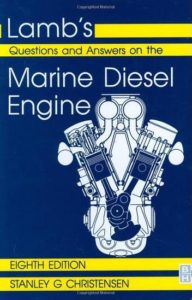Lambs Questions and Answers on the Marine Diesel Engine
Author(s)
Stanley G. Christensen
Publisher
Arnold
Date
1990
Pages
277
Format
pdf
Size
44.7 Mb

– – – – – – download – – – – – –
In technology, matter is sometimes referred to as material substance. It can be defined as anything known to exist and occupy space. Any material substance consists of minute particles known as molecules; these are the smallest particles of a substance which can exist and maintain all the properties of the original substance. A molecule is made up of a combination of two or more atoms of the elements. The atom consists of various parts which are held together by forces, recognized as being electrical in character. The forces of attraction come about from unlike electrical charges. The constituent parts of an atom are the central core or nucleus which has a positive charge and one or more electrons. The electron has a negative charge. The nucleus is composed of protons and neutrons (except the atom of hydrogen). Protons have positive electrical charges and the neutrons are electrically neutral. When an atom is electrically neutral it will have the same number of protons and electrons. The number of electrons contained in an atom is shown by the atomic number of the element. An atom becomes an ion when the number of electrons is more or less than the number of protons. The ion will be positive or negative according to the predominant electrical charge. The atom of hydrogen is the simplest; it consists of one proton and one electron. If the electron is removed from the atom of hydrogen the remaining proton becomes a hydrogen ion which will be positive. In some cases two atoms of the same element may differ in the number of neutrons contained in the nucleus. The atomic weights will therefore be different and the atoms are described as being isotopes of the element. The isotopes of an element have identical chemical properties but differing physical properties. The electrons outside the nucleus control the properties of the atom, and the protons and neutrons in the nucleus determine its atomic weight. The electrons are considered to form a series of orbital envelopes or cases around the nucleus, each envelope containing a set pattern of electrons. Other particles exist but need not concern us in this study.
Category: MARINE ENGINEERING
Thanks very interesting blog!
Wow, wonderful blog layout! How long have you been blogging for?
you made blogging look easy. The overall look of your web site is great,
let alone the content!
I do trust all the ideas you’ve introduced for your post.
They’re really convincing and can definitely
work. Nonetheless, the posts are too brief for novices.
May just you please extend them a bit from subsequent time?
Thanks for the post.
Pretty! This has been an extremely wonderful post. Thank you for providing this information.